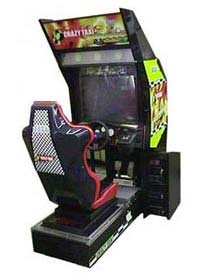Crazy Taxi
The franchise has been recognized for its innovative gameplay design which is easy to learn but difficult to master,[2] its use of in-game advertising, and its soundtrack music provided by the bands The Offspring and Bad Religion.
The player controls one of several taxi drivers in a fictional city, looking for fares and then taking them to their destination in the fastest time possible.
[5] The player can use special "crazy stunt" moves such as drifts, jumps, and near-misses, and consecutive combos of these, to earn extra money from the passenger during the trip.
The core gameplay in the series has been praised as being "deceptively complex";[2][5] as stated by the IGN staff for their review of the Dreamcast version of Crazy Taxi:[2] As you progress through the game's ratings scale by picking up and delivering passengers as quickly as possible, you will slowly but surely realize that there is much more to the game than getting from point a to b.Starting with Crazy Taxi 2, the gameplay included the ability to pick up a party of passengers, each having a different destination.
[8] Mini-games were developed for this version as to "let the player play longer if he improved skill" by offering challenges that were both fun and educational.
The arcade and initial home console versions include selections from punk rock bands The Offspring and Bad Religion, though these have been removed in both the Game Boy Advance and the PlayStation Portable remakes because of licensing issues.
In 2001, Electronic Arts and Fox Interactive released The Simpsons: Road Rage, which reviews identified as being clearly inspired by the gameplay of Crazy Taxi.
[20][21][22] In this game, the player controlled one of The Simpsons characters as they drive around Springfield, bringing passengers to these destinations in a way like in Crazy Taxi.
In December 2001, Sega brought Fox Entertainment, Electronic Arts, and developer Radical Games Ltd. to court over this infringement of the 138 patent.
The game introduced four cab drivers as well as two new maps based on NYC (called "Around Apple" and "Small Apple"), and added two gameplay features: the mechanics of collecting multiple passengers from a single spot, and the "Crazy Hop", allowing the taxi to clear traffic and certain obstacles with short jumps.
[33] The game allows the player to unlock other modes of transport besides the taxi, including a stroller, a pedal bike and a carriage.
[34] Crazy Taxi: Catch a Ride was ported to the Game Boy Advance by Graphics State and distributed by THQ,[35] and released on April 8, 2003.
[17] Specifically, while the city and streets are rendered using 3D graphics, the taxi, passengers, and other traffic are represented by sprites to work on the limited GBA hardware.
[36] Richard Whittall, creative director for Graphics State, noted that Catch A Ride was "about the most technically challenging game you could do on a handheld machine" at the time of its release.
[40] Crazy Taxi: City Rush was announced by Sega in March 2014 as a free-to-play mobile title for iOS and Android systems.
City Rush is a mission-based runner similar in concept to Temple Run, where the player does not have direct control of the speed of the taxi but can use touch motions to swerve in traffic and make turns.
[1] The game was praised for capturing the arcade flavor, and possibly exceeding it by making the controls and execution of the crazy stunts easier to perform.
[2] The game did suffer from "pop-up" due to limited draw distances, and loss of frame rate when a large number of cars were on the screen.
[2][62] Critics noted the lack of depth given that it was a port of an arcade game, some difficulties with the destination arrow, and the poor "Wolfman Jack" impersonation of the in-game announcer.
[2][62] Crazy Taxi 2 was well received by reviewers with the new features helping to expand play from the original game, though some thought that more drastic changes could have been made in the sequel.
[65][66] Graphic problems plagued the Crazy Taxi: Catch a Ride port to the Game Boy Advance; as IGN stated, "it's painfully obvious that the hardware just was never meant to push so much".
Reviews have complimented the game on the multiplayer additions and the ability to add a custom soundtrack – which led IGN to comment that "including this should be a no-brainer, but many PSP titles don't" – but have noted some graphical glitches, the long loading times, and the lack of the original soundtracks for the games.
[70] GameSpot's review noted that the gameplay in Crazy Taxi does not hold up well compared to more recent racing games across various platforms.
[76] The movie would have been tied with other merchandise items such as T-shirts and toys, according to Jane Thompson, director of licensing for Sega of America.
[78] After this option expired, Mindfire Entertainment acquired the rights to a Crazy Taxi movie based on the game franchise in 2002,[79] with an then-expected release date in mid-2003.
[81] Sega has formed the production company Stories International and teamed up with Evan Cholfin for film and TV projects based on their Crazy Taxi games.




